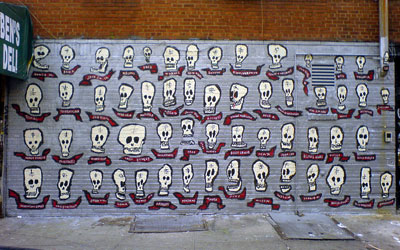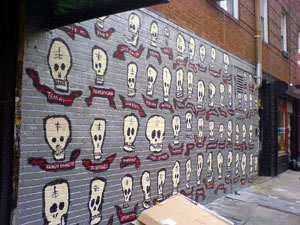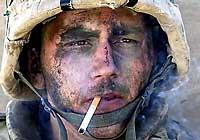January 2006
East Village Memorial

This memorial is painted on the side of Mamma’s Food Shop on 6th street and Avenue C. Click the image above for a larger version. The mural is signed by Taboo!, an East Village drag queen. I couldn’t find much about her online except mention (and a photo) in this old Wigstock release.
The piece commemorates a mix of stars, artists, drag queens, and others. Some died of AIDS, others were East Village locals. Some names I recognize, others I do not. Members of a family quietly fading.

Contextual Advertising Gone Bad
A week before today’s 61st anniversary of the liberation of Auschwitz by the Red Army, Landeszeitung Lüneburg, a local newspaper in Germany, ran an article about the deportation of a Sinti boy from Lüneburg to Auschwitz.
The article was accompanied by a large red ad from one of the biggest energy companies in Germany bearing the tagline (roughly translated): “E.ON provides today for the gas of tomorrow!”
Click for a larger version.
The paper later published an apology to the author, readers, and energy company for the ad placement, claiming they had not checked the content of the ad.
Roger, Roger
There is a new bilingual design magazine here in Germany. We already have at least four design magazines (depending on what you deem design), but ROGER matches or surpasses most of them. And ROGER is certainly the only German design magazine the rest of the world should care about, because it is the only one that cares.
While reading design magazines and design news sources online I am often appalled by the lack of social responsibility, critical reflection, and political wisdom. People hail works of designers even if the client earns his money from, say, exploitation in the global south, undemocratic regimes, or the arms trade — as long as the aesthetic value of the design work is somewhat recognizable. Not being a designer myself, but often in need of design services, I have met and worked with many designers who share the same impression. I love well designed websites or magazines — indeed I collect them. And there is a new item in my collection: the third issue of ROGER with “International Angst” as the main topic. It combines both design and responsibility.
ROGER tackles design related questions with a holistic and interdisciplinary approach. It closes the gap between your usual design magazine and political types like Adbusters and Consumerevolution. It is the closest yet to a “social design magazine.”
The current issue focuses on the “culture of fear” discussing its effects on society and on designers developing products to match customer demands in a market driven by irrational necessities. The issue features a range of articles addressing the premise from different angles. Whether it is a report from the International Design Action Day (IDAD) or a background article on the reasons for setting up Esuvee.com, a site warning about the dangers of Sports Utility Vehicles, or an interview with the curator of MoMA’s SAFE exhibition, it is always clear that the topic is more than just design. ROGER shows design can be more than aesthetics or selling products. True design is about shaping, shaping our society or future ones. No wonder a feature article on Buckminster Fuller introduces the idea of design science. The magazine itself sounds a little like a scientific project too, to prove that designers can indeed take responsibility.
ROGER is published by the KISD Club, an association of students from the Köln International School of Design. Because the magazine is bilingual, in both English and German, some articles are a little short and the pages, a little crowded. ROGER’s motto “Design People Questions” is also more ambitious than it appears at first. So much more that the magazine sometimes fails to meet its own ambitions. The article about a Chinese design fair called TIC 100 doesn’t really distuinguish between mainland China and Taiwan. It also forgets to mention the conflict between Taiwan and the Chinese government, a bloody regime that does not hesitate to jail reporters or kill students.
Still, the Editorial of the second issue, which is partly available online, expresses more than I can paraphrase:
“Design tends to be misunderstood and the self-presentations of the primadonnas contribute to this.... It would be better to reorganize those living and consuming circumstances that have become completely absurd and yet serve as a desirable example everywhere.... Luckily, some designers are already conscious of their responsibility.”
Find out more at http://roger.kisd.de/
Design Cares
DesignCares.com is a site collecting current examples of graphic projects in the public interest. Some nice elegant work, thus far mostly from Canada and mostly printed matter for non-profits and “children’s charities,” along with an occasional “random act of graphic vigilantism.”
From the site:
“We are collecting professional acts of social responsibility, as an inspiration for those looking for ideas, and as a celebration of the role designers are taking in helping repair the world....
Inspired by the Design Cares Web site, in 2001 the GDC Vancouver Island Chapter created the Design Cares Exhibit and Forum (with the generous support of Sappi Fine Papers, Adobe Systems, and others), and has published a travelling poster exhibit from the juried show. The Design Cares travelling exhibit is a celebration of the role designers are taking in helping to improve the world and shows the breadth and depth of how they use their creative skill to improve the human condition, save the environment or assist with a myriad charitable causes. The show has travelled internationally, including Slovenia, Qatar, Hungary, and Bahrain.”
DesignCares was started by members of the Society of Graphic Designers of Canada, a non-profit professional trade assocation:
The Society of Graphic Designers of Canada (GDC), a non-profit organization of design practitioners and educators. The GDC is concerned with standards of professional conduct, practice and integrity; education and professional development; and information about the profession. The organization was founded to promote and develop a defined, recognized and competent body of graphic designers and to encourage high standards of graphic design for the benefit of Canadian industry, commerce and community. The national goals of the Society include a commitment to improving the human environment by improving the quality of life and fostering public awareness of design expertise. Members share a code of ethics stating that we must take a responsible role in the visual portrayal of people, the consumption of natural resources, and the protection of animals and the environment.
Swap-O-Rama-Rama
What is Swap-O-Rama-Rama?
“Swap-O-Rama-Rama is not your regular clothing swap. The event features an entire day of how-to workshops, on site thematic workstations and a gathering of skilled designers, artists and do-it-yourselfers brought together to share their knowledge.
Workshops are taught by local artists of all calibers and cover wide range of skill sets and material uses. The swap has offered technology based workshops including a demo by Mikey Sklar that demonstrated how to replace pockets with metallic fiber for the purpose of creating a wearable faraday cage to block RFID tag readers, and an exploration of a playable sonic fabric created from recycled cassette tape presented by Alyce Santoro. Swap workshops also introduce completely new textiles. Kate Sweater offered a how-to that transforms plastic grocery bags into a new textile for wallets, bags and shoes. Traditional crafts like embroidery, knitting, beading and appliqué can also be found. If guests want to be hands-on they can slide over to any number of do-it-yourself workstations. These include a sewing stations with several sewing machines run by knowledgeable clothing and costume designers; an iron-on station for downloading images off the web and transferring them directly onto clothing; silk screening, and decoration stations for working with beads, buttons, and a variety of accoutrements.
The core of the swap is the gigantic piles of free clothing sorted into categories: pants, shirts, skirts, sweaters etc. These piles are the collective total of each guest’s contribution of one bag of unwanted clothes. This contribution is required to attend the event. Once inside guests are encouraged to take home ‘as much clothing as you can carry.’... All left over clothing is donated to St. Martin DePorres Shelter in Brooklyn, New York.
Swap-O-Rama-Rama was created out of a recognition that consumerism needs to be unlearned.”
The next Swap-O-Rama-Rama is on Sunday, Feburary 12 at Galapagos in Williamsburg.
The associated performance art, fashion show, and venue position it in a rather white, hipster way — more thrift-store chic than alternative economy. But it sounds like some grassroots, DIY fun. Find out more at http://www.swaporamarama.org
Also of note, “Swap-O-Rama-Rama has received funding support from Black Rock Arts, a community resource for interactive arts that sprouted from the makers of the art festival and utopian experiment Burning Man.” Let 1,000 DIY art-happenings bloom!
Update: Because of snow, Swap-O-Rama-Rama has been rescheduled Monday (Presidents Day) February 20th 2pm to 7pm.
Canada Out of Haiti!
Reader dru writes in about this graphic campaign around the upcoming elections in Canada:
“In February 2004, Canada backed a coup that removed Haiti’s democratically elected president (Aristide) and the entire elected government. Since then, they’ve been training police that have been shooting demonstrators, and propping up a ‘justice’ system that is systematically jailing political dissidents (the ones that aren’t in hiding or dead).
A bunch of Haiti solidarity activists are trying to unseat the Foreign Minister, Pierre Pettigrew (who had a brief cameo in The Corporation as a corrupt international trade minister), who played a key role (and continues to) in backing the post-coup government.
In the last election, he won by a very small margin in his riding of Papineau in north Montreal, which has a high population of Haitians.
In conjunction with groups in the Haitian community there, we're waging an all-out propaganda battle to unseat Pettigrew. Thousands of these posters: http://outofhaiti.ca/pettigrew/
Similar flyers have been distributed in the riding, and we hope to get a few thousand more out before election day (Jan. 23). Because the riding is such a hotspot, our posters have appeared on two nationally-broadcast TV news shows (in French and English).
Posters have also been created for the Prime Minister and his special advisor on Haiti and are going up in cities all across Canada.”
Read more about the campaign at http://outofhaiti.ca/
The Consumption of Space
 In November 2003, I blogged Edward Mazria’s analysis of the environmental impact of architecture in the U.S. Namely, that buildings are responsible for a whopping 46 percent of carbon dioxide production in the U.S.
In November 2003, I blogged Edward Mazria’s analysis of the environmental impact of architecture in the U.S. Namely, that buildings are responsible for a whopping 46 percent of carbon dioxide production in the U.S.
Yesterday, Mazria and company launched a Web site to spread the word and promote a response. From the press release:
“www.architecture2030.org is part of an ongoing effort, initiated by architect Edward Mazria, to provide information and innovative solutions in the fields of architecture and planning, in an effort to address and reverse the destructive trend toward global climate change.
The website clearly illustrates, using the latest research, that the Building sector is currently responsible for about half of all U.S. and global emissions annually and that this sector’s emissions are increasing at an alarming rate. Architecture2030.org outlines the steps necessary to address this situation. As part of this effort, the website includes a variety of resources to help professionals, government officials, and those in the building sector, plan and design for a carbon-neutral future....
The website will report on the activities and progress in the building sector around the globe and critical information will be updated regularly.”
In particular, I liked the case studies.
Also of particular note is the organizing work of the American Institute of Architects, a professional association:
“The American Institute of Architects, representing 74,000 prefessionals, recently announced a bold initiative to reverse the environmental impact and greenhouse gas emissions of the U.S. building sector. The AIA... set a goal of reducing the fossil fuel consumption of buildings by 50 percent in four years, with additional 10-percent reductions every five years thereafter. The implications of this initiative are considerable and when implemented will transform the built environment in a way we have not seen since the time of the industrial revolution.”
Up in Smoke
Back in November 2004, a portrait of a U.S. Marine in Iraq rapidly became an icon of weary, insouciant toughness and cool that so many love in their cinematic heros.
 Patrick J. McDonnell wrote in the Los Angeles Times:
Patrick J. McDonnell wrote in the Los Angeles Times:
A smoke break creates icon of the war; now groupies seek out the weary Marine
“Miller is the young man whose gritty, war-hardened portrait, shot by Luis Sinco, a Los Angeles Times photographer, appeared Wednesday in more than 100 U.S. newspapers, including The Seattle Times. In the full-frame photo, taken after more than 12 hours of nearly nonstop deadly combat, Miller’s camouflage war paint is smudged. He sports a bloody nick on his nose. His helmet and chin strap frame a weary expression that seems to convey the timeless fatigue of battle. And there is the cigarette, of course, drooping from the right side of his mouth in a jaunty manner that Humphrey Bogart would have approved of. Wispy smoke drifts off to his left.
The image has quickly moved into the realm of the iconic.
More than 100 newspapers printed it, although it took the New York Post to sum it up in a front-page headline: ‘Marlboro Men Kick Butt in Fallujah.’ The fact that Miller’s name was not included in the caption material only seemed to enhance its punch....
The photo was taken on the afternoon after Charlie Company’s harrowing entry into Fallujah under intense enemy fire, in the cold and rain. Miller was on the roof of a home where he and his fellow First Platoon members had spent the day engaged in practically nonstop firefights, fending off snipers and attackers who rushed the building. No one had slept in more than 24 hours. All were physically and emotionally drained.”
See this previous post on Bag News Notes for further analysis of the Times article and photo.
See also Human Rights Watch‘s report on Charlie Company‘s earlier seige and occupation of Fallujah.
Today, however, we learn from Editor and Publisher that:
‘Marlboro Man’ in Iraq War Photo Suffers from PTSD
Back home, he got married in June, but on duty during the Hurricane Katrina relief effort, Miller suffered from symptoms of post-traumatic stress disorder (PTSD), and was granted an honorable discharge from the Marines in November....
Miller went into therapy, but knows he is not alone. ‘A lot of guys have had way worse incidents from being in Iraq,’ he said. ‘And I guess it just -- it troubled me due to the fact that their incidents may have been more severe, and they weren’t suffering from the same things I was. I just didn’t understand how it could affect me so dramatically and not affect some of these guys. But a lot of them deal with different ways.
‘The more and more I talk to [other guys], the more I found out there were a lot of Marines that are going through same or similar emotions. It’s tough to deal with. Being in Iraq is something no one wants to talk about.’”







